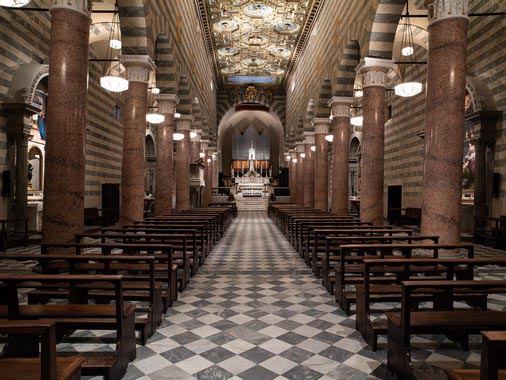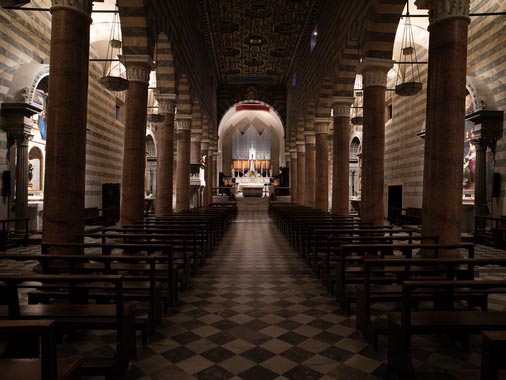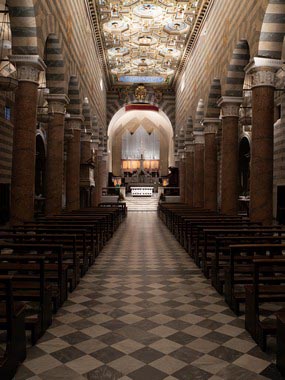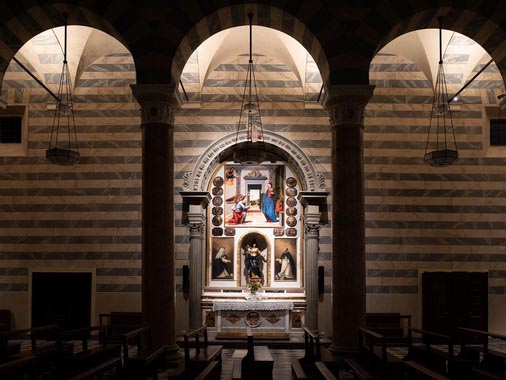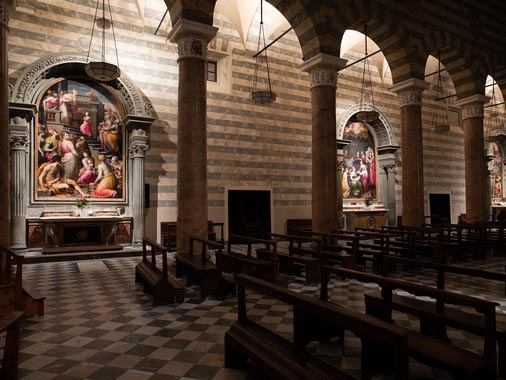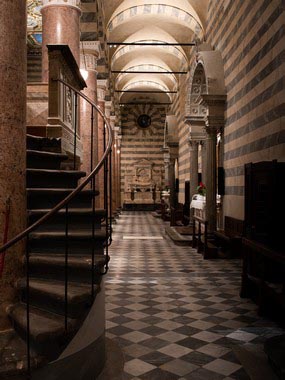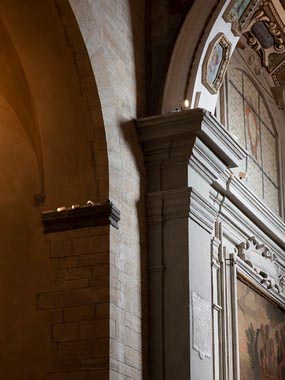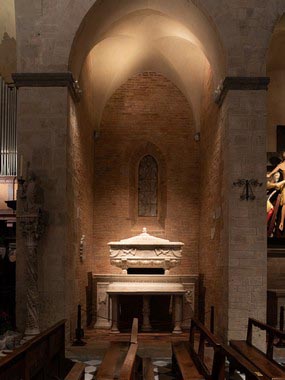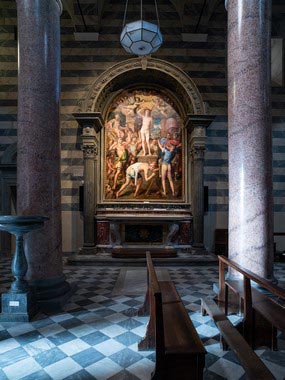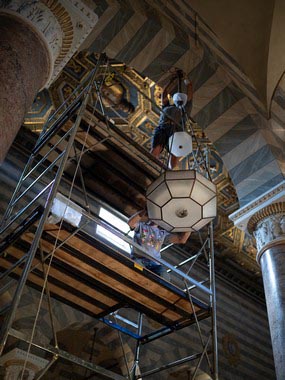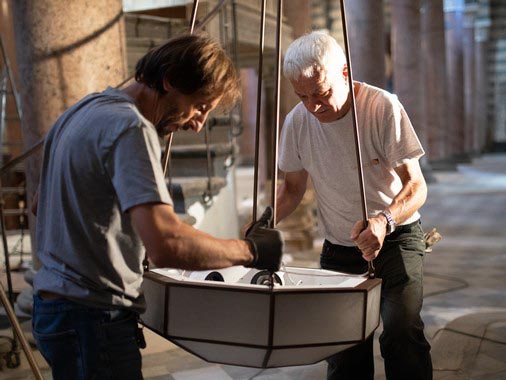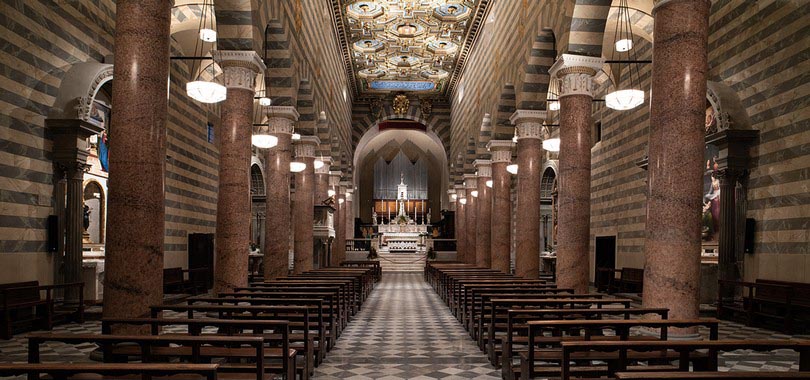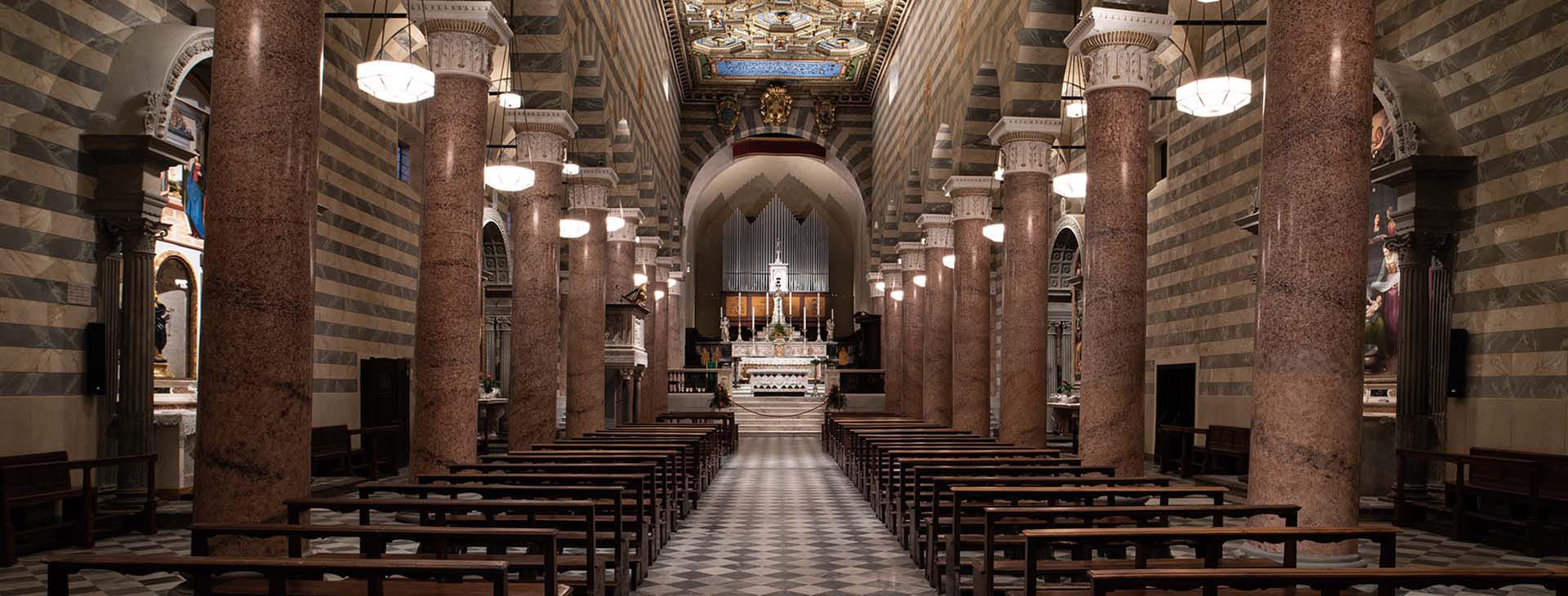
City: Volterra, Pisa
Country: Italy
Architectural Design: Giorgio Bascià
Lighting Design: Arch. Massimo IarussiVolterra is the city of alabaster, well-known and visited by discerning tourists looking for less-known artistic treasures but of great historical-artistic value. The cathedral of Santa Maria Assunta is one of these places, the symbol of medieval Volterra and one of the finest examples of Pisan Romanesque architecture. Consecrated in 1120, the cathedral is home to both precious antique and modern works of art. In 2016 to mark the 900th anniversary of its consecration the diocese in Volterra decided to start restoration work on the whole church, both architectural and structural work including the lighting system. The lighting project was entrusted to the architect and lighting designer Massimo Iarussi given his particular talent and experience in the historical-artistic field.
The project is once again in-keeping with the concept of “light that remains in the background”, as Iarussi likes to define it where light does not intend to take centre stage, be self-referential and an end in itself, but appears to be rather "organic" to the space that surrounds it; perceived as intrinsic in the space. Visitors can enjoy the entire space and not specifically its light.
The central nave
With the same aim the architect decided to design particular suspension fixtures made of alabaster for diffused lighting in the church and to hide the projectors that light the coffered ceiling.
This idea was dictated by the already present overlapping of elements and styles from different eras inside the church, which make it a work of inestimable artistic value. The space, while retaining the Latin-cross basilica shape with three naves also has a late Renaissance aspect. The coffered ceiling dates back to the late sixteenth century while the stucco coating on the columns, the floor and the walls painted in white and grey bands all date back to restoration work carried out the nineteenth century.
The suspension fixtures therefore add a new element to the Cathedral, an expression of artistic and artisan work from the third millennium. The entire project has a common theme of softness of light and perfect balance of luminance between the various areas of the church. Everywhere architectural details have been used to install fixtures and hide them as much as possible from view, except for the lanterns that also become important decorative elements. The central nave is lit with diffused light from the new alabaster lanterns positioned below the arches that divide the naves. This is a tribute that the lighting designer wanted to pay to the city, the European capital for processing this precious mineral. The lanterns represent the masterful work of different artisans. The artisan who worked on the alabaster, the blacksmith who made the metal structure and Targetti who designed the technological heart.
The R&D department at Targetti created a kind of metal tray to house the fixtures for different lighting scenes. The lanterns play a triple role of contributing to the general lighting in the church, lighting the coffered ceiling and providing a more scenographic zenith light for the floor. A kind of ring made of LED strips surrounds the metal tray to provide a backlight for the alabaster suspension fixtures. Inside they are equipped with custom-made projectors inspired by the ZENO range, fitted with a special adjustable bracket to light the coffered ceiling. Finally, in the lower part of the lanterns there are small recessed projectors derived from the LABEL 24 V range which are fixed to the metal trays using rods which zenithally light the floor.
The side naves
The side naves are light indirectly. A decision was made to enhance the vaulted ceiling using linear lighting positioned on the existing chains. The effect is extremely soft without any particular focus. The lighting designer studied the right power and the distances between the walls so as not to create any blurring. Black 48 V tracks to light LABEL mini projectors are also attached to the chains to light the side chapels that are filled with precious frescoes.
The altar area
The altar area is sober in terms of lighting sculptures and religious elements. Lighting is provided by custom-made projectors inspired by the ZENO range, positioned on a metal plate rather than on a track which light different vertical planes: the face of the celebrant and the altar that is home to the holy relics. The organ behind the majestic altar is lit with reflected light coming from the apse ceiling to leave it almost in dim light in order to focus attention on elements of more religious significance.
Particular attention was paid to the front chapels of the transept which are home to the main works of art in the cathedral, such as the beautiful wooden deposition of Christ. They have preserved their medieval character, escaping subsequent alterations and are lit with low luminance levels and warmer tones.
All lighting is managed using a sophisticated DALI BUS system that makes it possible to create different scenes according to requirements, both in museums and places of worship. The cathedral on one hand is a place of continuous pilgrimage for visitors to Volterra, on the other, seeing as it is an episcopal see it performs various religious functions from simple gatherings for recollection and prayer to more solemn services. Iarussi created 8 different scenes where the different sculptural and architectural elements are treated differently – by dimming the lights – depending on the time the scene is used during services. For example, the historic high altar (the pre-conciliar one where the celebrant has his back to worshipers) is slightly dimmed during liturgical services so as not to compete with the modern conciliar altar facing towards the faithful which is the fulcrum of the scene.
In the scenes designed for tourist visits or concerts on the other hand the focus is on the historic altar which constitutes the fulcrum of the architecture, while the contemporary altar is left in the shadow.
A similar criteria is also applied to the paintings and all the other architectural elements: elements that constitute a symbolic reference to liturgical aspects are only lit lightly during tourist visits where there are no services; on the contrary those with predominantly artistic value are in the shadows during services. Solemn occasions therefore create a link by maximising all the works of art and architectural elements.
All the scenes can be recalled using a push-button panel located in the sacristy of the church which means that it is easily accessible to all those involved in managing the Cathedral.
Country: Italy
Architectural Design: Giorgio Bascià
Lighting Design: Arch. Massimo IarussiVolterra is the city of alabaster, well-known and visited by discerning tourists looking for less-known artistic treasures but of great historical-artistic value. The cathedral of Santa Maria Assunta is one of these places, the symbol of medieval Volterra and one of the finest examples of Pisan Romanesque architecture. Consecrated in 1120, the cathedral is home to both precious antique and modern works of art. In 2016 to mark the 900th anniversary of its consecration the diocese in Volterra decided to start restoration work on the whole church, both architectural and structural work including the lighting system. The lighting project was entrusted to the architect and lighting designer Massimo Iarussi given his particular talent and experience in the historical-artistic field.
The project is once again in-keeping with the concept of “light that remains in the background”, as Iarussi likes to define it where light does not intend to take centre stage, be self-referential and an end in itself, but appears to be rather "organic" to the space that surrounds it; perceived as intrinsic in the space. Visitors can enjoy the entire space and not specifically its light.
The central nave
With the same aim the architect decided to design particular suspension fixtures made of alabaster for diffused lighting in the church and to hide the projectors that light the coffered ceiling.
This idea was dictated by the already present overlapping of elements and styles from different eras inside the church, which make it a work of inestimable artistic value. The space, while retaining the Latin-cross basilica shape with three naves also has a late Renaissance aspect. The coffered ceiling dates back to the late sixteenth century while the stucco coating on the columns, the floor and the walls painted in white and grey bands all date back to restoration work carried out the nineteenth century.
The suspension fixtures therefore add a new element to the Cathedral, an expression of artistic and artisan work from the third millennium. The entire project has a common theme of softness of light and perfect balance of luminance between the various areas of the church. Everywhere architectural details have been used to install fixtures and hide them as much as possible from view, except for the lanterns that also become important decorative elements. The central nave is lit with diffused light from the new alabaster lanterns positioned below the arches that divide the naves. This is a tribute that the lighting designer wanted to pay to the city, the European capital for processing this precious mineral. The lanterns represent the masterful work of different artisans. The artisan who worked on the alabaster, the blacksmith who made the metal structure and Targetti who designed the technological heart.
The R&D department at Targetti created a kind of metal tray to house the fixtures for different lighting scenes. The lanterns play a triple role of contributing to the general lighting in the church, lighting the coffered ceiling and providing a more scenographic zenith light for the floor. A kind of ring made of LED strips surrounds the metal tray to provide a backlight for the alabaster suspension fixtures. Inside they are equipped with custom-made projectors inspired by the ZENO range, fitted with a special adjustable bracket to light the coffered ceiling. Finally, in the lower part of the lanterns there are small recessed projectors derived from the LABEL 24 V range which are fixed to the metal trays using rods which zenithally light the floor.
The side naves
The side naves are light indirectly. A decision was made to enhance the vaulted ceiling using linear lighting positioned on the existing chains. The effect is extremely soft without any particular focus. The lighting designer studied the right power and the distances between the walls so as not to create any blurring. Black 48 V tracks to light LABEL mini projectors are also attached to the chains to light the side chapels that are filled with precious frescoes.
The altar area
The altar area is sober in terms of lighting sculptures and religious elements. Lighting is provided by custom-made projectors inspired by the ZENO range, positioned on a metal plate rather than on a track which light different vertical planes: the face of the celebrant and the altar that is home to the holy relics. The organ behind the majestic altar is lit with reflected light coming from the apse ceiling to leave it almost in dim light in order to focus attention on elements of more religious significance.
Particular attention was paid to the front chapels of the transept which are home to the main works of art in the cathedral, such as the beautiful wooden deposition of Christ. They have preserved their medieval character, escaping subsequent alterations and are lit with low luminance levels and warmer tones.
All lighting is managed using a sophisticated DALI BUS system that makes it possible to create different scenes according to requirements, both in museums and places of worship. The cathedral on one hand is a place of continuous pilgrimage for visitors to Volterra, on the other, seeing as it is an episcopal see it performs various religious functions from simple gatherings for recollection and prayer to more solemn services. Iarussi created 8 different scenes where the different sculptural and architectural elements are treated differently – by dimming the lights – depending on the time the scene is used during services. For example, the historic high altar (the pre-conciliar one where the celebrant has his back to worshipers) is slightly dimmed during liturgical services so as not to compete with the modern conciliar altar facing towards the faithful which is the fulcrum of the scene.
In the scenes designed for tourist visits or concerts on the other hand the focus is on the historic altar which constitutes the fulcrum of the architecture, while the contemporary altar is left in the shadow.
A similar criteria is also applied to the paintings and all the other architectural elements: elements that constitute a symbolic reference to liturgical aspects are only lit lightly during tourist visits where there are no services; on the contrary those with predominantly artistic value are in the shadows during services. Solemn occasions therefore create a link by maximising all the works of art and architectural elements.
All the scenes can be recalled using a push-button panel located in the sacristy of the church which means that it is easily accessible to all those involved in managing the Cathedral.
Products used
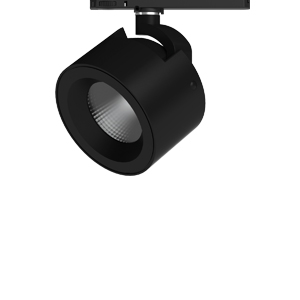
ZENO Medium
Colour rendering index: 97Fixture flux Min/Max: 1901lm-2695lmSize: Ø 134mm
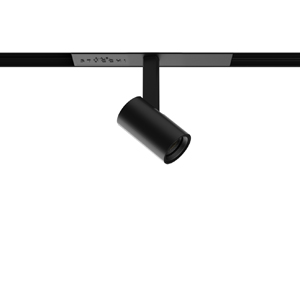
FORTYEIGHT Label 2
Colour rendering index: 90Fixture flux Min/Max: 124lm-164lmSize: Ø 23mm
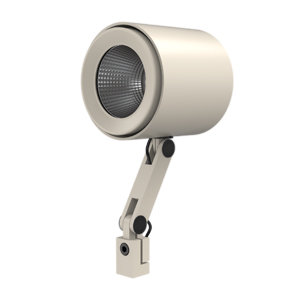
CORO 120
Colour rendering index: 90Fixture flux Min/Max: 1534lm-5320lmSize: Ø 119mm
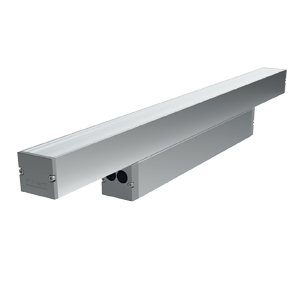
JEDI COMPACT Indoor
Colour rendering index: 90Fixture flux Min/Max: 3361lm-5478lmSize: 850mm-1130mm
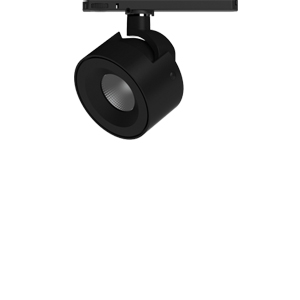
ZENO Small
Colour rendering index: 97Fixture flux Min/Max: 825lm-1478lmSize: Ø 105mm
Other projects in the same category
